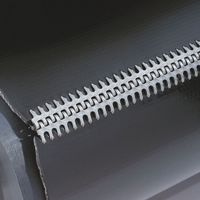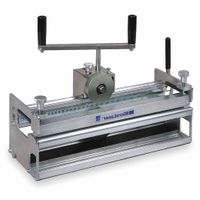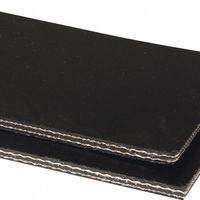Call +(254) 703 030 000 / 751 483 999 / 721 704 777
- Home
- Material Handling
- Transporting
- Conveyors Components
- Belt Conveyors Components
.....Read More
Frequently Asked Questions
What are the main components of a belt conveyor?
The main components of a belt conveyor include:
1. **Belt**: The continuous loop of material that carries the load. It is typically made of rubber, fabric, or metal, depending on the application.
2. **Pulleys**: These are cylindrical devices that drive and guide the belt. The two main types are the drive pulley, which provides the force to move the belt, and the tail pulley, which helps guide the belt back to the drive pulley.
3. **Motor**: Provides the necessary power to drive the conveyor belt. It is usually connected to the drive pulley via a gearbox or direct drive.
4. **Idlers**: Rollers that support the belt and the load it carries. They are placed at intervals along the conveyor to maintain belt alignment and reduce friction.
5. **Frame**: The structure that supports the belt, pulleys, and idlers. It is typically made of steel or aluminum and provides stability and alignment for the conveyor components.
6. **Take-up Unit**: A system that maintains the proper tension in the belt to prevent slippage and ensure smooth operation. It can be a screw or gravity take-up system.
7. **Belt Cleaner**: Devices that remove material sticking to the belt to prevent buildup and maintain efficiency. They are usually located at the discharge end.
8. **Loading and Discharge Chutes**: Structures that guide the material onto and off the conveyor belt, minimizing spillage and ensuring efficient transfer.
9. **Safety Devices**: Include emergency stop switches, pull cords, and guards to protect workers and equipment from accidents.
10. **Control System**: Manages the operation of the conveyor, including start/stop functions, speed control, and monitoring of system performance.
How do you maintain a belt conveyor system?
To maintain a belt conveyor system, follow these steps:
1. **Regular Inspection**: Conduct routine inspections to check for wear and tear, misalignment, and any unusual noises. Inspect the belt surface, pulleys, rollers, and frame for damage.
2. **Belt Alignment**: Ensure the belt is properly aligned to prevent uneven wear and potential damage. Misalignment can cause the belt to drift, leading to spillage and increased wear.
3. **Tension Adjustment**: Maintain proper belt tension to avoid slippage and excessive wear. Over-tensioning can cause stress on the belt and components, while under-tensioning can lead to slippage.
4. **Cleaning**: Keep the belt and surrounding area clean to prevent material build-up, which can cause misalignment and increased wear. Use scrapers and brushes to remove debris.
5. **Lubrication**: Regularly lubricate bearings, rollers, and other moving parts to reduce friction and wear. Use the appropriate lubricant as specified by the manufacturer.
6. **Component Replacement**: Replace worn or damaged components such as rollers, bearings, and belt sections promptly to prevent further damage and downtime.
7. **Safety Checks**: Ensure all safety guards and emergency stop mechanisms are functional. Regularly test these systems to ensure they operate correctly in an emergency.
8. **Training**: Train personnel on proper operation and maintenance procedures to prevent misuse and ensure timely identification of issues.
9. **Documentation**: Keep detailed records of maintenance activities, inspections, and repairs to track the system's condition and plan future maintenance.
10. **Preventive Maintenance Schedule**: Develop and adhere to a preventive maintenance schedule based on the manufacturer's recommendations and the system's operating conditions.
By following these steps, you can ensure the efficient and safe operation of a belt conveyor system, minimizing downtime and extending its lifespan.
What are the advantages of using belt conveyors?
Belt conveyors offer several advantages, making them a popular choice in various industries:
1. **Efficiency**: Belt conveyors provide a continuous and efficient means of transporting materials over long distances, reducing the need for manual labor and increasing productivity.
2. **Versatility**: They can handle a wide range of materials, including bulk items, small parts, and packaged goods, making them suitable for diverse applications across industries like mining, agriculture, and manufacturing.
3. **Cost-Effectiveness**: With low operational and maintenance costs, belt conveyors are a cost-effective solution for material handling. They require minimal energy consumption compared to other transport methods.
4. **Flexibility**: Belt conveyors can be designed to fit specific operational needs, with adjustable lengths, widths, and inclines. They can navigate curves and changes in elevation, allowing for customized layouts.
5. **Safety**: By automating the transport process, belt conveyors reduce the risk of workplace injuries associated with manual handling. They can also be equipped with safety features like emergency stop buttons and guards.
6. **Reliability**: Built with durable materials, belt conveyors are designed for long-term use and can operate in harsh environments, including extreme temperatures and corrosive conditions.
7. **Scalability**: They can be easily expanded or modified to accommodate changes in production volume or facility layout, providing scalability for growing operations.
8. **Minimal Spillage**: With proper design and maintenance, belt conveyors minimize material spillage, ensuring efficient transport and reducing waste.
9. **Automation Integration**: Belt conveyors can be integrated with automated systems for sorting, weighing, and packaging, enhancing overall operational efficiency.
10. **Reduced Environmental Impact**: By optimizing material transport, belt conveyors can contribute to reduced energy consumption and lower carbon emissions, supporting sustainable practices.
How do you calculate the load capacity of a belt conveyor?
To calculate the load capacity of a belt conveyor, follow these steps:
1. **Determine Belt Width and Speed**: Identify the width of the belt and its speed. These are crucial for calculating the conveyor's capacity.
2. **Calculate Belt Area**: Use the formula:
\[
\text{Belt Area} = \text{Belt Width} \times \text{Belt Speed}
\]
This gives the area of the belt that passes a point per unit time.
3. **Material Cross-Sectional Area**: Determine the cross-sectional area of the material on the belt. This depends on the material's angle of repose and the belt's troughing angle. Use the formula:
\[
\text{Material Cross-Sectional Area} = \text{Belt Width} \times \text{Material Height} \times \text{Troughing Factor}
\]
4. **Material Density**: Obtain the bulk density of the material being conveyed, usually in kg/m³ or lb/ft³.
5. **Calculate Load Capacity**: Use the formula:
\[
\text{Load Capacity} = \text{Material Cross-Sectional Area} \times \text{Belt Speed} \times \text{Material Density}
\]
This gives the load capacity in units of weight per time (e.g., kg/hr or tons/hr).
6. **Adjust for Incline**: If the conveyor is inclined, adjust the capacity using the angle of inclination. The effective capacity decreases with an increase in the angle of inclination.
7. **Consider Safety Factors**: Apply safety factors to account for variations in material properties, belt wear, and operational conditions.
By following these steps, you can determine the load capacity of a belt conveyor, ensuring it meets the operational requirements and safety standards.
What types of materials can be transported using belt conveyors?
Belt conveyors are versatile systems used to transport a wide range of materials across various industries. They are particularly effective for moving bulk materials and can handle both solid and semi-solid materials. Here are the types of materials commonly transported using belt conveyors:
1. **Bulk Materials**: These include loose, granular, or lumpy materials such as coal, ore, sand, gravel, and grain. Belt conveyors are ideal for moving these materials over long distances efficiently.
2. **Agricultural Products**: Items like grains, seeds, and fertilizers are often transported using belt conveyors in agricultural settings, facilitating easy movement from storage to processing areas.
3. **Food Products**: In the food industry, belt conveyors are used to transport items like fruits, vegetables, nuts, and packaged goods. They are designed to meet hygiene standards and can be customized for specific food handling requirements.
4. **Industrial Goods**: Belt conveyors are used to move manufactured goods, including boxes, cartons, and pallets, in warehouses and distribution centers.
5. **Construction Materials**: Materials such as cement, bricks, and concrete are transported using belt conveyors on construction sites, aiding in efficient material handling.
6. **Recyclable Materials**: In recycling facilities, belt conveyors transport materials like paper, plastic, glass, and metals for sorting and processing.
7. **Chemical and Pharmaceutical Products**: Belt conveyors are used to move powders, granules, and other chemical products in controlled environments, ensuring safe and efficient handling.
8. **Waste and Scrap Materials**: In waste management, belt conveyors transport waste materials for sorting, recycling, or disposal.
9. **Textiles and Fabrics**: In the textile industry, conveyors move fabrics and other materials through various stages of production.
Belt conveyors can be customized with different belt materials, widths, and configurations to suit specific material handling needs, making them a crucial component in many industrial processes.
How do you troubleshoot common issues with belt conveyors?
To troubleshoot common issues with belt conveyors, follow these steps:
1. **Belt Slippage**: Check for proper tension and alignment. Adjust the tensioning system and ensure the drive pulley is clean and free from contaminants.
2. **Belt Mistracking**: Inspect the alignment of the belt and adjust the tracking idlers. Ensure that the conveyor frame is square and level. Check for material buildup on rollers and pulleys.
3. **Excessive Wear**: Examine the belt for signs of wear and tear. Replace worn-out components and ensure that the belt is suitable for the material being conveyed. Check for sharp edges or obstructions along the conveyor path.
4. **Material Spillage**: Verify that the belt is properly loaded and centered. Adjust skirt boards and install proper sealing systems. Ensure that the belt speed is appropriate for the material type.
5. **Belt Tear or Damage**: Inspect for foreign objects or sharp edges that may cause damage. Regularly check the belt for cuts or tears and repair or replace as necessary.
6. **Noise and Vibration**: Identify loose components or misaligned parts. Tighten bolts and ensure that all components are securely fastened. Check for worn bearings or rollers and replace them if needed.
7. **Motor and Drive Issues**: Ensure that the motor is properly sized and functioning. Check electrical connections and inspect the drive system for wear. Lubricate moving parts as required.
8. **Overloading**: Monitor the load capacity and ensure it is not exceeded. Implement load sensors and alarms to prevent overloading.
9. **Regular Maintenance**: Establish a routine maintenance schedule to inspect and service the conveyor system. This includes checking for wear, lubricating parts, and replacing damaged components.
By systematically addressing these areas, you can effectively troubleshoot and resolve common belt conveyor issues.
What safety measures should be taken when operating belt conveyors?
1. **Training and Awareness**: Ensure all operators and maintenance personnel are adequately trained in conveyor operation and safety protocols. Regularly update training to include new safety measures and technologies.
2. **Guarding**: Install guards around all moving parts, including pulleys, belts, and drive mechanisms, to prevent accidental contact. Ensure guards are securely fastened and regularly inspected for damage.
3. **Emergency Stop Mechanisms**: Equip conveyors with easily accessible emergency stop buttons or pull cords along the entire length of the conveyor. Test these mechanisms regularly to ensure functionality.
4. **Lockout/Tagout Procedures**: Implement strict lockout/tagout procedures during maintenance or repair work to prevent accidental start-up. Ensure all personnel are trained in these procedures.
5. **Regular Inspections and Maintenance**: Conduct routine inspections to identify wear and tear, misalignment, or other potential hazards. Schedule regular maintenance to address any issues promptly.
6. **Clear Signage**: Post clear warning signs and operational instructions near the conveyor. Use signs to indicate pinch points, emergency stops, and other critical safety information.
7. **Safe Loading and Unloading**: Ensure materials are loaded and unloaded safely to prevent spillage or overloading, which can lead to accidents or equipment damage.
8. **Personal Protective Equipment (PPE)**: Require the use of appropriate PPE, such as gloves, hard hats, and safety glasses, to protect against potential hazards.
9. **Housekeeping**: Maintain a clean and clutter-free environment around the conveyor to prevent tripping hazards and ensure clear access to emergency stops.
10. **Monitoring Systems**: Utilize monitoring systems to detect belt misalignment, slippage, or other operational issues. Implement alarms to alert operators to potential problems.
11. **Communication**: Establish clear communication protocols among operators, maintenance personnel, and supervisors to ensure coordinated and safe operation.



